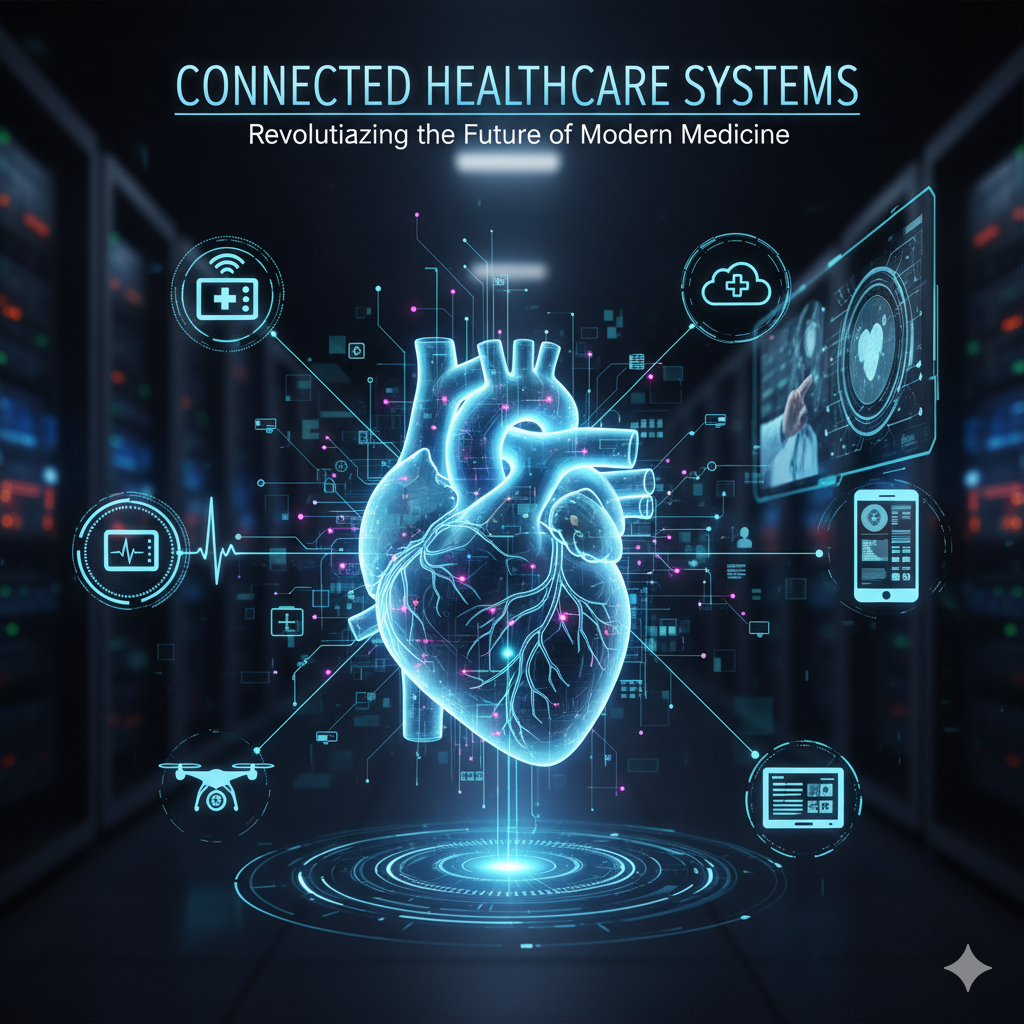Connected Healthcare Systems: Revolutionizing the Future of Modern Medicine
Connected Healthcare Systems

In today’s digital age, healthcare is no longer confined within the walls of hospitals or clinics. Thanks to connected healthcare systems, the medical industry is undergoing a remarkable transformation. This innovative approach integrates technology, data, and communication tools to provide patients and healthcare professionals with seamless access to information, improved care coordination, and real-time health insights. As the world continues to embrace digital transformation, connected healthcare is becoming the backbone of a more efficient, patient-centered medical ecosystem.
The Evolution of Connected Healthcare Systems
Healthcare has come a long way from traditional paper-based records and isolated clinical practices. The evolution of connected healthcare systems began with the adoption of electronic health records (EHRs), telemedicine, and wearable technologies. Over time, these systems have evolved into an interconnected web of digital solutions that enable healthcare providers, patients, and insurers to share and access data effortlessly.
In the past, patients often had to carry their medical history from one doctor to another, leading to fragmented care and repetitive tests. Connected systems have solved this problem by creating centralized platforms where patient data is stored securely and can be accessed instantly. Today, healthcare professionals can collaborate across specialties, reducing errors and improving diagnostic accuracy. This not only saves time but also enhances the quality of care delivered to patients.
The adoption of cloud technology, artificial intelligence (AI), and the Internet of Things (IoT) has further accelerated this transformation. From smart medical devices that monitor vital signs to mobile apps that remind patients to take their medication, every element of the healthcare ecosystem is now becoming interconnected and intelligent.
How Connected Healthcare Systems Work
At its core, a connected healthcare system operates on the principle of data integration. It connects various stakeholders—hospitals, clinics, laboratories, pharmacies, and even patients—through a shared digital infrastructure.
Smart sensors, wearable devices, and mobile health applications continuously collect patient data such as heart rate, blood pressure, and glucose levels. This information is transmitted securely to healthcare providers, who can analyze it in real time. With AI-driven analytics, potential health risks can be detected early, allowing for timely interventions.
For example, a diabetic patient wearing a continuous glucose monitor can have their data automatically sent to their physician. If glucose levels fluctuate abnormally, the doctor receives an alert and can adjust the treatment plan immediately. This kind of proactive care is made possible only through the interconnectedness of healthcare technologies.
Additionally, connected healthcare systems support interoperability—the ability of different digital systems and devices to communicate effectively. This ensures that patient data remains consistent and up to date across all healthcare touchpoints, regardless of the software or platform used.
Benefits of Connected Healthcare Systems
The advantages of connected healthcare systems extend far beyond convenience. They are reshaping how healthcare is delivered, monitored, and experienced.
- Improved Patient Outcomes:
Continuous monitoring and early detection of anomalies allow doctors to intervene before conditions worsen. This results in better disease management and faster recovery times. - Enhanced Efficiency:
By reducing redundant paperwork and automating routine tasks, connected systems save time for both patients and healthcare providers. Physicians can focus more on patient care rather than administrative duties. - Cost Reduction:
Real-time data sharing minimizes the need for repeated diagnostic tests and unnecessary hospital visits. Preventive care enabled by connected systems also reduces long-term healthcare costs. - Patient Empowerment:
Patients gain access to their health data through mobile apps and online portals. This transparency encourages them to take a more active role in managing their health and lifestyle choices. - Better Collaboration:
Specialists, primary care doctors, and even pharmacists can easily collaborate through integrated platforms. This ensures that treatment plans are cohesive and based on accurate, up-to-date information.
Challenges in Implementing Connected Healthcare Systems
Despite the many advantages, the implementation of connected healthcare systems comes with its challenges.
Data Security and Privacy: With the growing amount of health data being exchanged online, cybersecurity threats have become a major concern. Healthcare organizations must ensure that sensitive patient information is protected from breaches and misuse.
Interoperability Issues: While many digital platforms exist, not all of them communicate effectively with one another. Lack of standardization often creates data silos, limiting the potential of connected healthcare.
High Implementation Costs: Developing and maintaining digital infrastructure can be expensive, especially for smaller healthcare facilities. However, as technology becomes more affordable, this challenge is gradually being addressed.
User Adoption: Both patients and healthcare providers need to adapt to new digital tools and workflows. Training and awareness programs play a key role in ensuring successful adoption.
The Role of AI and IoT in Connected Healthcare
Artificial Intelligence and the Internet of Things are at the heart of connected healthcare innovation. AI algorithms can analyze massive datasets to identify trends, predict health risks, and assist in diagnosis. For instance, AI-powered imaging tools can detect abnormalities in X-rays or MRIs faster and with greater accuracy than traditional methods.
Meanwhile, IoT devices such as smartwatches, fitness trackers, and connected medical sensors continuously monitor health parameters. This data not only provides real-time insights but also supports long-term health management. Together, AI and IoT create a dynamic feedback loop that enhances decision-making and promotes preventive care.
In the coming years, these technologies will continue to evolve, leading to even smarter healthcare systems capable of delivering highly personalized treatment plans.
The Future of Connected Healthcare Systems
The future of healthcare is undoubtedly connected. As more organizations embrace digital transformation, the healthcare ecosystem will become more efficient, predictive, and patient-centric. Emerging technologies like blockchain could further strengthen data security, while 5G connectivity will enable faster and more reliable real-time communication.
Moreover, connected healthcare systems will play a crucial role in addressing global health challenges. From remote patient monitoring in rural areas to AI-assisted teleconsultations during pandemics, the possibilities are limitless.
Ultimately, the goal is to create a world where every individual has access to continuous, coordinated, and data-driven healthcare—anytime and anywhere.
Conclusion
Connected healthcare systems are redefining how we perceive and experience healthcare. By bridging the gap between patients, providers, and technology, these systems are building a smarter, more inclusive healthcare environment. As innovations in AI, IoT, and data analytics continue to advance, connected healthcare will not only improve patient outcomes but also make medical services more accessible and efficient. The journey toward a fully connected healthcare future has already begun—and it promises to revolutionize the way we care for our health in the years to come.



